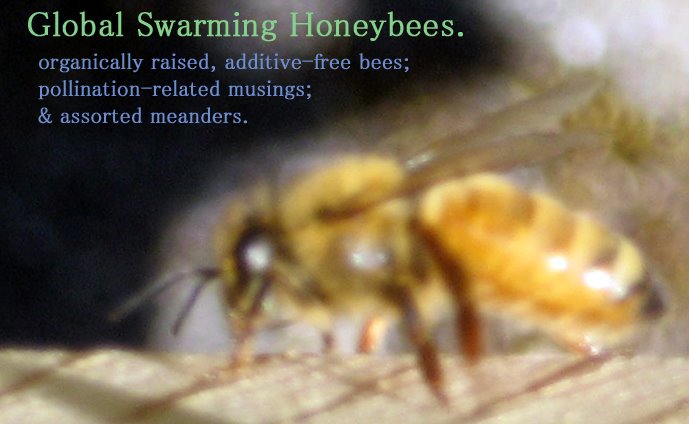9.30.2008
9.25.2008
Zinnia Zap

 The zinnias—in their "Different Brilliant Colors"—provide one of the garden's last nectar sources for the honeybees and other pollinators. Zinnia + borage + sunflowers + tomatillo blossoms = all that remains on the garden front, nectar-wise. (Fortunately, even after last week's light frost, the fields remain rich in goldenrod and aster, which the bees are working with frenzied effort as the foraging season winds down.)
The zinnias—in their "Different Brilliant Colors"—provide one of the garden's last nectar sources for the honeybees and other pollinators. Zinnia + borage + sunflowers + tomatillo blossoms = all that remains on the garden front, nectar-wise. (Fortunately, even after last week's light frost, the fields remain rich in goldenrod and aster, which the bees are working with frenzied effort as the foraging season winds down.)
This bumblebee captured my attention the other day, not only for its impressive size, but because it was slow-going, which made it possible for me to enjoy the sight of the morning sunlight illuminating its fuzzy exterior. Bumblebees are usually more skittish than honeybees, and quicker to buzz off, as it were, when the paparazzi arrives. 
See the pic below for a better look.



Some beekeepers become incensed when predators "get" their bees. Birds, for example, are described in some beekeeping guides as "pests" of the honeybee. So are frogs, which have enough troubles of their own without being maligned by beekeeping textbooks. I've even read posts from people on organic beek groups threatening to shoot cardinals or scarlet tanagers who "dare" to pick off their bees.
Please. That's the way the food chain crumbles. Yes, I'm saddened to see a bee taken by a spider or bird or whatever, but I also know that bees are no more exempt from the food chain system than the rest of us (lest we forget that we too become grist for the nature-mill, by and by). One reason Mother Nature, in her pretty much infinite wisdom, creates colonies consisting of tens of thousands of honeybees is that danger, predation, mortality are part of the game. Deal with it.
Besides, I like spiders. Is that so wrong?
9.14.2008
On Plumbing, Snakes, & Hay
Warning: If you do not wish to see my septic tank, read no further!


The other day, after much procrastinating, I finally got around to sprinkling the seed on the now hard-as-rock ground, raked it in (not really), and then covered it (sort of) with a light layer of hay, as per the Lawn Guy's directive.
I did this all half-heartedly because: (a) I don't really care about the lawn; (b) I don't think terribly well of lawns as an ecological proposition, but am too lazy to painstakingly rake leaves off a moss garden once a week or plant a million shrubs in its place; and (c) I have a trillion other outdoor projects to attend to. But the Lawn Guy told me to do it, and I never mess with the Lawn Guy.
The truth is, I love playing with hay. For one thing, I adore the smell. It reminds me of being a kid at farm camp and jumping into mounds of soft, dry, sweetly aromatic hay in the Pennsylvania hayloft, as August light eked through the slatted barn beams and Richard Nixon resigned. Happy memories!
I also love playing with hay because it's full of fabulous life forms that, in hauling, disassembling, and redistributing the bales, I get to commune with. For example, after unloading my first bale from the wheelbarrow, I met these cool spiders.

I didn't have to catch this one, though. S/he was found slithering around in the wheelbarrow after I removed one of the bales. A lovely garter snake. Haven't seen many this summer; too cool and damp. They're out there, of course, but they're keeping a low profile.


Having finished my reverie amongst the snakes and spiders, I found my attention grabbed anew by the subtle, intricate beauty of the cut, dried, and compacted grasses and other herbaceous material that populate a bale of hay. 
8.07.2008
As if from nowhere...



6.04.2008
Recent Things






















